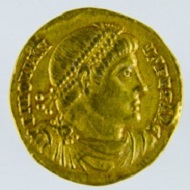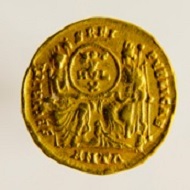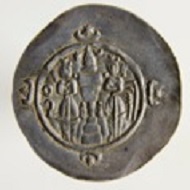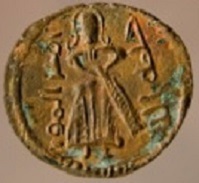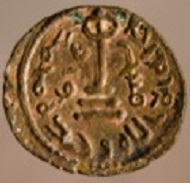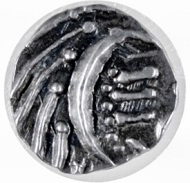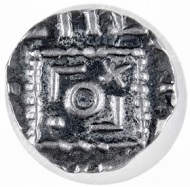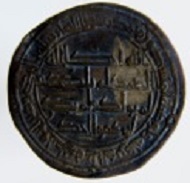April 21, 2016 – After over two years of work, FLAME (Framing the Late Antique and early Medieval Economy), a digital humanities project with twenty five participants and staff from the United States and Europe, is ready to conclude its first stage. In an upcoming conference on April 29-30, 2016 it will share the results of its participants’ research on the economy of Western Afro-Eurasia during the periods of Late Antiquity and the early Middle Ages, a tumultuous era that included the Fall of the Roman Empire, the Origin of Europe, and the Rise of Islam.
Roman Empire, Jovian, 363-64, gold solidus. Source: Princeton University Numismatic Collection, Department of Rare Books and Special Collections, Firestone Library.
FLAME brings together an unprecedented amount of data about ancient coins, as its first stage covers all minting activity between Ireland and Iran over four centuries and reveals long-term trends for the first time. For each of the six hundred or so mints in the FLAME area of interest, its online database will provide information about the minting of sixty denominations and thousands of issues, all at an annual level of resolution when possible. FLAME’s modular design also allows for easy future chronological and spatial expansion.
Sassanian Empire, Khusrau II, 580-628, silver drachm. Source: Princeton University Numismatic Collection, Department of Rare Books and Special Collections, Firestone Library.
The upcoming conference will bring FLAME’s members to Princeton, together with a group of experts on the ancient economy – Florin Curta (University of Florida), Richard Hobbs (The British Museum), Stefan Heidemann (University of Hamburg), Marek Jankowiak (Oxford University), Jonathan Jarrett (University of Leeds), Cécile Morrisson (Collège de France), Vivien Prigent (Centre d’Histoire et Civilisation de Byzance, Orient et Méditerranée) and Peter Sarris (Cambridge University). The conference will be accompanied by a special exhibit of relevant coins from the Princeton University Numismatic Collection. The conference on the grounds of Princeton University is open to the public; free advance registration (including lunch on April 30) and information may be had from the program’s director, Lee Mordechai.
Arab-Byzantine, 690-702, mint of Manbij, copper fals, from the Antioch excavations. Source: Princeton University Numismatic Collection, Department of Rare Books and Special Collections, Firestone Library.
FLAME was conceived in Princeton, building upon the university’s strengths in the fields of Late Antiquity and early medieval history. Its chair, Alan Stahl, is Princeton’s numismatist, while its director and manager, Lee Mordechai, is a graduate student in the History Department. Princeton faculty members John Haldon and Helmut Reimitz, six graduate students, and four undergraduates have served as the project’s core, working alongside faculty members, post-docs and graduate students from other institutions in collecting and analyzing large amounts of data on coin production and circulation with the aid of a unique mapping application developed for this purpose.
Anglo-Frisian, c. 700, silver sceatta. Source: Princeton University Numismatic Collection, Department of Rare Books and Special Collections, Firestone Library.
At the conference, the project’s website coinage.princeton.edu will go live with interactive maps showing the issues of all mints over the four centuries under study. After the conference, FLAME will move on to its more ambitious second phase, in which it will collect and analyze data about the find contexts of a million coins from thousands of publications from the region. “The potential for aggregating so much data is enormous once we can start analyzing it. We don’t usually use the term ‘Big Data’ in ancient history since very little survives, but this is as close as it gets for us“, says Mordechai. Although FLAME’s main effort is geared towards scholarly use by non-numismatists, “it is extremely important for us to stay in touch with the interested public, and our site will cater to that demographic by providing them with introductory resources to share our findings about this crucial period”.
Umayyad Caliphate, AH 122 [CE 739-40], mint of Wasit, silver dirham. Source: Princeton University Numismatic Collection, Department of Rare Books and Special Collections, Firestone Library.
The FLAME project and conference have been generously sponsored by Princeton University’s Committee for the Study of Late Antiquity; Department of Rare Books and Special Collections, Firestone Library; Center for Collaborative History and the History Department; Sharmin and Bijan Mossavar-Rahmani Center for Iran and Persian Gulf Studies; PIIRS (Princeton Institute for International and Regional Studies); Stanley J. Seeger ‘52 Center for Hellenic Studies; Program in the Ancient World; Graduate School, Department of Art & Archaeology; Program in Medieval Studies; and Center for Digital Humanities.
Check out the project’s website after the conference although the website is online already (under major construction).





